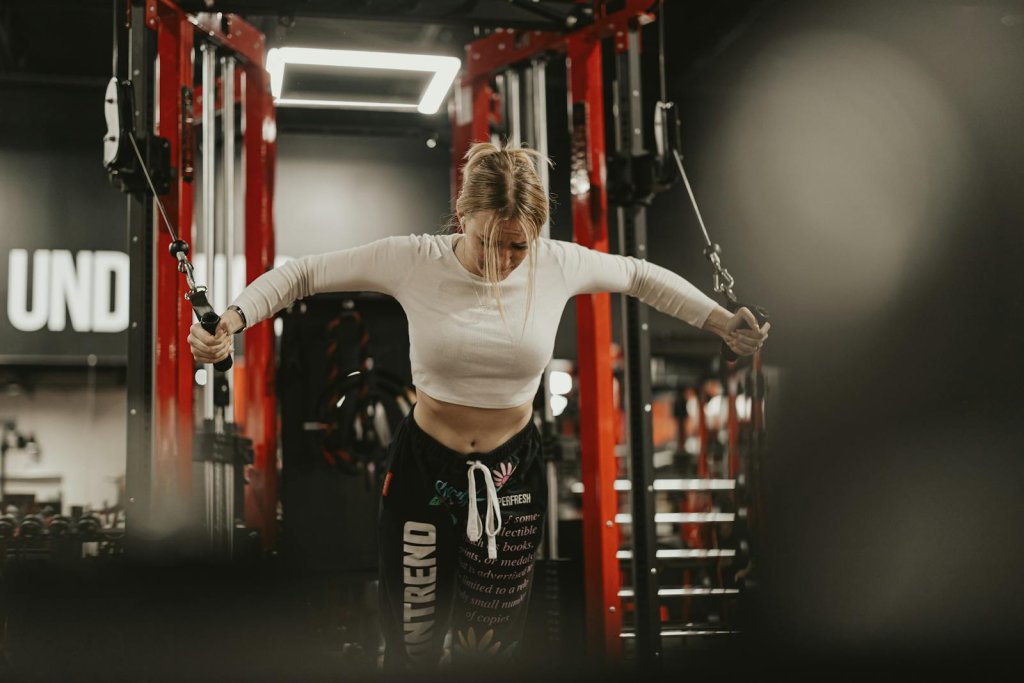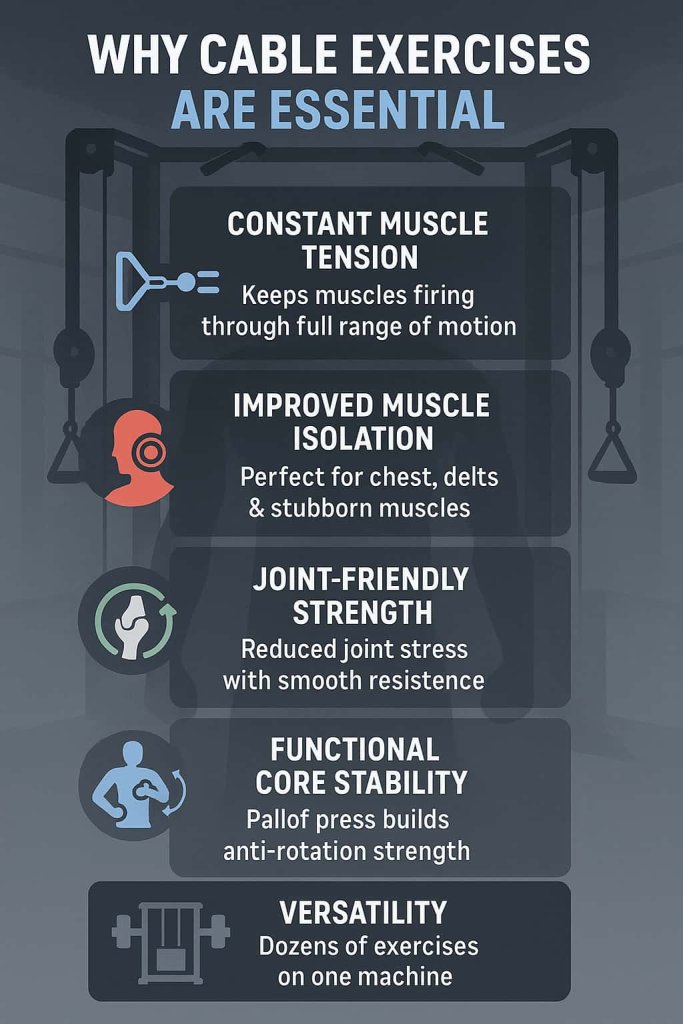Yes, cable exercises are among the best ways to build muscle and strength because they provide constant resistance and target muscles through their full range of motion. Unlike free weights, which lose tension at certain angles, cable machines maintain steady pressure from start to finish. This makes them excellent for hypertrophy, strength, stability, and joint-friendly training.

If you want to grow a bigger chest, thicker back, stronger shoulders, or well-defined arms, the cable machine should be in your routine. In this guide, we’ll cover the 17 best cable exercises for every major muscle group, complete with benefits, step-by-step instructions, trainer tips, and FAQs.
Why Cable Exercises Are Essential
Cable workouts are more than just an accessory to free weights. Here’s why they matter:

- Constant Muscle Tension: Cables keep your muscles firing throughout the movement.
- Improved Muscle Isolation: Ideal for hitting specific areas like rear delts or inner chest.
- Joint-Friendly Strength: Smooth resistance reduces stress on shoulders, elbows, and knees.
- Functional Core Stability: Moves like the Pallof press build anti-rotation strength.
- Versatility: One machine lets you perform dozens of exercises safely.
👉 According to the American Council on Exercise (ACE), cable training enhances muscular endurance and hypertrophy while lowering injury risk compared to uncontrolled free-weight lifting.
17 Best Cable Exercises
Below are the 17 best cable exercises, complete with step-by-step instructions and trainer tips.
1. Lat Pulldown
Muscles Worked: Lats, biceps, traps, rhomboids.
How to Do It:
- Sit at the lat pulldown station with your knees secured.
- Grip the bar slightly wider than shoulder-width.
- Pull the bar down toward your upper chest.
- Squeeze your back at the bottom, then slowly return to the top.
Trainer Tip: Keep your chest up and avoid leaning too far back. This is the #1 cable move for building a wider V-shaped back.
2. Reverse Grip Lat Pulldown
Muscles Worked: Lower lats, biceps.
How to Do It:
- Use an underhand (supinated) grip, hands shoulder-width apart.
- Pull the bar down to your chest, keeping elbows close to your torso.
- Control the bar back up slowly.
Trainer Tip: Perfect for emphasizing the lower lats and improving overall back thickness.
3. Seated Cable Row
Muscles Worked: Mid-back, rhomboids, traps, biceps.
How to Do It:
- Sit tall with knees slightly bent.
- Grip the V-handle or straight bar.
- Row toward your torso, leading with elbows.
- Squeeze shoulder blades together, then return under control.
Trainer Tip: Avoid leaning back too much—let your lats, not momentum, drive the movement.
4. Straight Arm Lat Pushdown
Muscles Worked: Lats (isolation).
How to Do It:
- Stand tall and grip a straight bar with arms extended overhead.
- Pull the bar downward to your thighs in a sweeping arc, elbows locked.
- Slowly return to the starting position.
Trainer Tip: One of the best isolation moves for deep lat activation—great for finishing your back workout.
5. Cable Face Pull
Muscles Worked: Rear delts, traps, rotator cuff.
How to Do It:
- Attach a rope at upper chest height.
- Pull toward your face, elbows high and wide.
- Focus on external shoulder rotation at the top.
Trainer Tip: Excellent for posture correction and shoulder health. Do this at least twice weekly to balance pressing work.
6. Cable Chest Press
Muscles Worked: Pecs, shoulders, triceps.
How to Do It:
- Set the pulleys at chest height.
- Step forward into a staggered stance.
- Press the handles forward like a bench press.
- Return slowly with control.
Trainer Tip: A joint-friendly alternative to barbell pressing with smoother resistance.
7. Cable Crossover (Fly)
Muscles Worked: Inner and outer chest.
How to Do It:
- Stand with cables in each hand, arms extended out to the sides.
- Bring handles together in front in a hugging motion.
- Return with a slow stretch.
Trainer Tip: Adjust pulley height:
- High pulleys → target lower chest.
- Low pulleys → target upper chest.
8. Incline Cable Bench Press
Muscles Worked: Upper chest, shoulders.
How to Do It:
- Set a bench at a 30–45° incline inside the cable machine.
- Grip the handles and press upward and inward.
- Lower slowly to stretch the chest.
Trainer Tip: Offers better tension across the range of motion than dumbbells.
9. Cable Pullover
Muscles Worked: Chest, lats, triceps.
How to Do It:
- Stand tall, holding a straight bar overhead.
- Pull the bar down in an arc toward your thighs, keeping arms straight.
- Return with control.
Trainer Tip: Focus on squeezing lats and chest—avoid bending elbows.
10. Cable Overhead Press
Muscles Worked: Shoulders, triceps.
How to Do It:
- Attach handles at the lowest pulley setting.
- Grip and press overhead, fully extending arms.
- Lower slowly to shoulder level.
Trainer Tip: Provides constant tension on the shoulders—great for hypertrophy.
11. Cable Lateral Raise
Muscles Worked: Side delts.
How to Do It:
- Stand beside the pulley, gripping the handle with one hand.
- Raise arm sideways until shoulder height.
- Lower with control.
Trainer Tip: Perform one arm at a time for strict isolation and full range of motion.
12. Cable Front Raise
Muscles Worked: Front delts.
How to Do It:
- Stand tall, grip the low pulley handle.
- Raise arm forward to shoulder height.
- Slowly return down.
Trainer Tip: Keep your core braced and avoid swinging.
13. Cable Upright Row
Muscles Worked: Traps, shoulders.
How to Do It:
- Grip a bar attached to the low pulley.
- Pull upward toward your chest, elbows leading high.
- Lower under control.
Trainer Tip: Use a slightly wider grip to reduce shoulder impingement risk.
14. Cable Tricep Pushdown
Muscles Worked: Triceps (all heads).
How to Do It:
- Attach a rope or straight bar at head height.
- Keep elbows close to sides.
- Push down until arms are fully extended.
- Return slowly.
Trainer Tip: Focus on full lockout for maximum tricep activation.
15. Cable Bicep Curl
Muscles Worked: Biceps, forearms.
How to Do It:
- Stand tall with bar handle in hands.
- Curl upward while keeping elbows fixed at sides.
- Lower under control.
Trainer Tip: Constant tension makes this superior to dumbbell curls for hypertrophy.
16. Cable Pull-Through
Muscles Worked: Glutes, hamstrings, lower back.
How to Do It:
- Face away from the machine with rope between legs.
- Hinge at hips, pulling rope forward as you extend hips.
- Squeeze glutes hard at the top.
Trainer Tip: Great for learning hip hinge mechanics without loading the spine heavily.
17. Pallof Press
Muscles Worked: Core stabilizers, obliques.
How to Do It:
- Stand sideways to the cable.
- Hold handle at chest height.
- Press arms straight forward, resisting rotation.
- Hold briefly, then return.
Trainer Tip: One of the best anti-rotation core exercises for injury prevention and athletic power.
How to Program Cable Exercises Into Your Workout
Knowing the best exercises is only half the equation—you also need to know how to use them effectively.
- For beginners: Add 2–3 cable moves per workout as accessory lifts.
- For intermediates: Use cables as finishers after compound barbell or dumbbell lifts.
- For advanced lifters: Try a cable-only day for joint-friendly hypertrophy.
👉 Example Push/Pull/Legs Split with cables:
- Push: Cable Chest Press + Lateral Raise
- Pull: Lat Pulldown + Seated Cable Row
- Legs: Cable Pull-Through + Pallof Press
Common Mistakes to Avoid With Cable Exercises
Even with the best equipment, mistakes can ruin results. Avoid these:
- Using Too Much Weight: Leads to jerking and poor form.
- Standing Too Far/Close: Cable should align with the muscle’s natural line of pull.
- Poor Posture: Rounded back or flared elbows reduce effectiveness and increase injury risk.
- Skipping Full Range of Motion: Short reps = less time under tension.
Sample Cable-Only Workout
Want a plug-and-play workout? Here’s a balanced cable-only routine:
- Chest: Cable Crossover – 3×12
- Back: Lat Pulldown – 3×10 + Seated Row – 3×10
- Shoulders: Cable Lateral Raise – 3×15
- Biceps: Cable Curl – 3×12
- Triceps: Rope Pushdown – 3×12
- Core: Pallof Press – 3×12 per side
Trainer Tip: Perform this 2–3 times per week for a complete, joint-friendly strength program.
Trainer Tips for Safe & Effective Cable Training
- Warm up before heavy sets (dynamic stretches, light cables).
- Prioritize form over load—avoid jerking or swinging.
- Adjust pulley height to match the muscle you’re targeting.
- Progress gradually: increase resistance 5–10% every 2–3 weeks.
- Mix cables with free weights for balanced strength.
Frequently Asked Questions
1. Are cable exercises better than free weights?
Not better—different. Cables provide constant tension and isolation, while free weights build raw power and stability.
2. Can beginners use cable machines?
Yes. They’re safer and easier to control than barbells or dumbbells.
3. How many cable exercises should I do per workout?
2–4 exercises are enough. Combine compound and isolation moves.
4. Do cable workouts build strength or just size?
Both. Heavy cable rows and presses build strength, while curls and flys emphasize hypertrophy.
5. What’s the best cable exercise for abs?
The Pallof Press and Cable Crunch are the most effective for core strength.
6. Should I replace free weights with cables?
Not entirely. For best results, combine cables with barbell/dumbbell work.
7. How often should I train with cables?
2–4 sessions per week depending on your program split.
Conclusion
Cable machines are often overlooked, but they can completely transform your training. By providing constant resistance, smoother joint-friendly motion, and versatile movement angles, they are perfect for both muscle growth and strength building.
If you want to maximize gains, add 3–5 of these 17 cable exercises into your weekly routine. Whether your goal is a wider back, bigger chest, sculpted arms, or stronger core, cables will deliver results safely and effectively.
